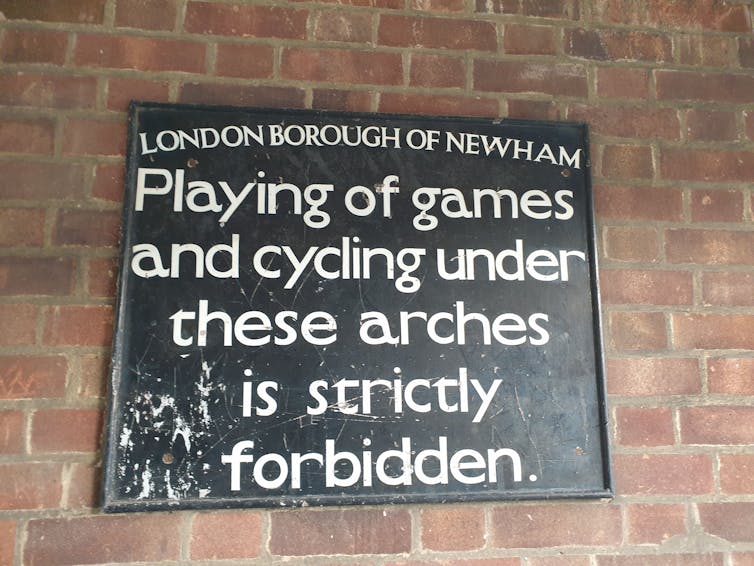By Shrehan Lynch
Growing up in the 80s as a child with lots of siblings, I played in the street until dark or until we were called for dinner. We had an amazing community of neighbours. However, one elderly neighbour hated us. Every time the football went into her garden, she would confiscate it – and then pop the ball. When she collected over 20 deflated footballs, she would take them down to the police station and complain. To her, at least, free and active children were a pest and a disgrace.
Our neighbour’s one-woman campaign didn’t deter us, though. Only one thing stopped us playing: the shattering of a window and the scream of a parent coming outside to tell us off. (Much harder to do nowadays with most windows being double-glazed.)
On reflection, I was probably part of the last generation of children to play outside regularly. Now in London, the estate I live in is covered with historic signs saying: “No ball games”.

The signs function as a play ban for children. Even during the summer, there are only a couple of rebels who dare to play football on the street. They get my nod and a kick of the ball back when it comes in my direction.
The problem is, many people don’t know that these signs are not enforceable by law: they are simply a request from local housing associations.
Of course, if people are kicking the ball against someone’s house or out on the streets making noise late at night, it would be considered criminal damage and antisocial behaviour – and quite right. But most of the time the signs are just preventing children from playing.
The London Sport charity has recommended that these signs are removed. I agree – let’s burn them all. But I do think it is simplistic to imagine banning the signs will combat a national obesity epidemic.
An unequal playing field
The Active Lives Survey shows that just 47% of children in England are getting the recommended 60 minutes or more of sport and physical activity a day. Removing “No ball games” signs doesn’t mean that the other 53% of children will feel motivated to venture outside and play.
The Active Lives Survey also suggests that boys are more likely to be active than girls. Perhaps boys are still given more activity opportunities. The Lionesses win at the Euros football tournament highlighted the lack of opportunities for girls in football and inequitable sports curriculums in schools.
Children and young people of black, Asian and other minority ethnicities are least likely to be active. Perhaps because racism in sport is alive and kicking?
Attitudes to high-profile athletes reflect systemic inequalities like racism and misogyny. Elite sports people continually face racist, homophobic and sexist abuse on and off the pitch. It isn’t surprising that sport isn’t an appealing – or safe – option for many minority ethnic children.
Access to sport and physical activity is a social justice issue
Family affluence is another major factor in children’s activity levels. Those who are less affluent are less likely to be active.
Access to sport and physical activity is a social justice issue that depends on location and financial circumstances. For a child from an economically disadvantaged background, who lives in a high-rise flat with little green space around, the costs and practicalities of participating in sport are prohibitive. For example, a weekend tennis court costs anywhere between £10 and £27, without travel or equipment.
So, while we can burn all the “No ball games” signs in the country, the real barrier to combating low activity levels in children is social inequality. What really needs to happen to get our children moving?
Reimagining accessibility to sports facilities for children
First, we need to reimagine the spaces in which we live, and understand the barriers children face. We could start by providing positive physical education experiences to young people in school then promote concessionary rates for community sport and physical activity spaces.
Councils could get on board with under-16s free swimming initiatives at a national level and increase the number of women-only swimming sessions. Safe bike routes are essential because, although active travel is an increasing trend, cyclists need to feel confident to use bikes as a dominant method of travel.
The issue is complex, but at least we’ve got double glazing to protect against footballs – it’s a start.




